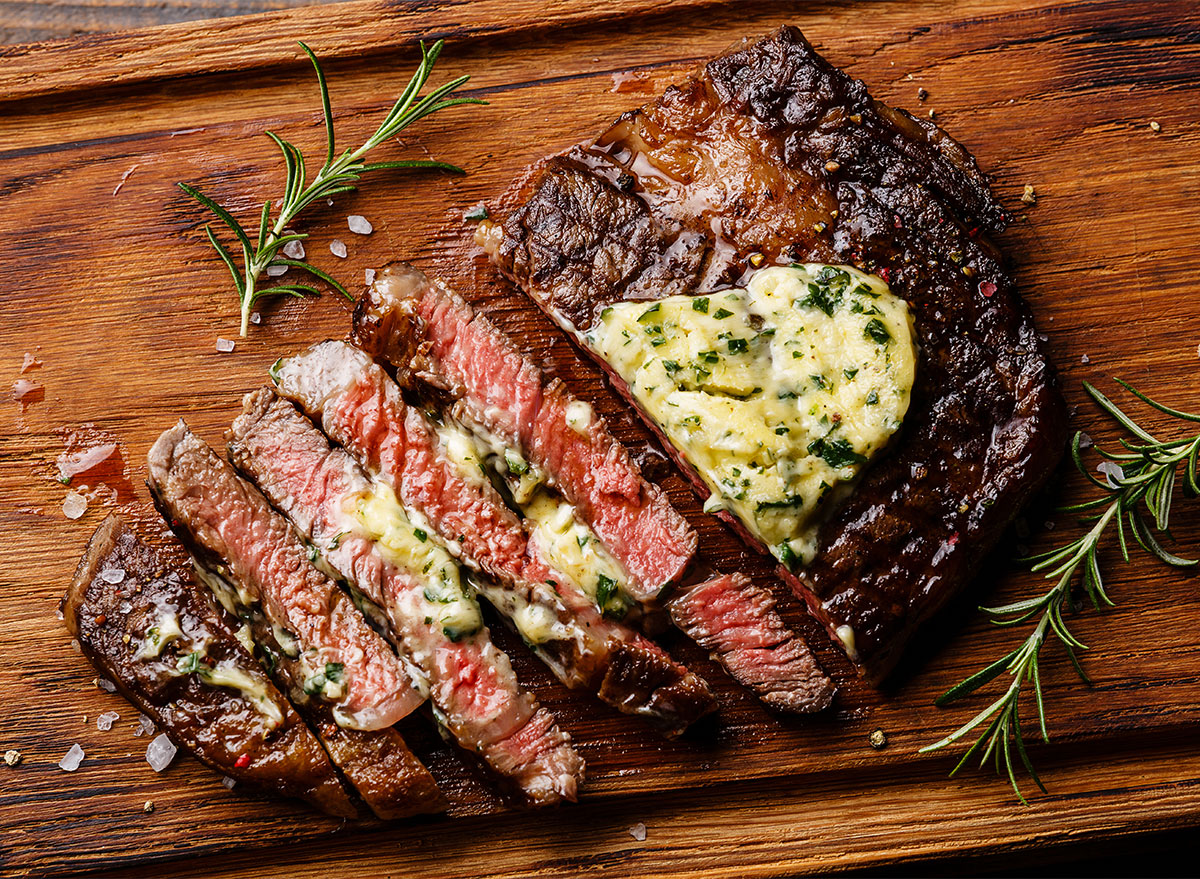Eating Beef Only Three Times a Week
As far as foods go, you'll be hard-pressed to find a category for more controversial than red meat. Some enthusiastic carnivores swear by eating steak on the regular, while others insist that it's downright terrible for you. There's no denying that red meat is an excellent source of high-quality protein, and it's chock full of essential vitamins and nutrients. But what if you're eating red meat every single day? What effects does it have on your body? Is there such a thing as too much?
According to the Centers for Disease Control and Prevention (CDC), the average American eats about 4 1/2 servings of red meat a week—and some 10% of the population eats at least two servings a day. Needless to say, Americans love their red meat.
However, the 2015–2020 Dietary Guidelines for Americans recommends limiting red meat intake to approximately one serving per week. For years, public health officials for years have urged people to minimize their consumption of red meat and processed meats due to concerns about their links to certain diseases and other health issues. But in 2019, a team of researchers concluded a series of reviews and found "low" evidence that consuming less red meat will reduce your risk for cancer and heart disease.
"Even the evidence that has found health risks in those who eat a lot of red meat could potentially be explained away by other lifestyle factors such as not eating enough vegetables, consuming large amounts of processed meat (in addition to fresh red meat) and/or saturated fats and refined sugar, and not getting enough exercise on a consistent basis," says Sean Allt, nutrition coach with Innovative Fitness.
Whether you frequently chow down on burgers, filets, or beef tacos (or enjoy all three), it's important to understand the implications that your red meat consumption has on your health. Below, experts dish on how eating red meat every day can impact your body—both in the short-term and the long-term. And for more healthy tips, check out our list of 21 Best Healthy Cooking Hacks of All Time.

According to Allt, certain cuts of red meat have a high saturated fat content—which has been shown to raise cholesterol. Specifically, eating foods with saturated causes your body to produce more LDL, the "bad" cholesterol that increases your risk of cardiovascular disease. That's why Allt says that ideally, just about ⅓ of your total fat intake should be coming from the saturated fat found in meat—the other ⅔ should be coming equally from monounsaturated fat (found in nuts and seeds) and polyunsaturated fat (found in certain fish).
"Cholesterol is a substance in your blood vessels that can build up over time and cause inadequate blood flow through the blood vessels (or worse, a total blockage)," says Amanda A. Kostro Miller, RD, LDN, a member of the advisory board for Smart Healthy Living. "In general, those who eat more unhealthy fats will have more of a problem with blood cholesterol."
If you're concerned about your cholesterol levels, registered dietician Shena Jaramillo recommends seeking out leaner cuts of red meat, which have less saturated fat (less than 2 grams per serving). For example, eye round roast and steak, sirloin tip side steak, top round roast and steak, bottom round roast and steak, and top sirloin steak are the leanest cuts. You may want to opt for cuts that are graded "Choice" or "Select" rather than "Prime," and always choose cuts with the least amount of visible fat (marbling). Additionally, according to Allt, a grass-fed version of the same cut of meat will typically have lower saturated fat content than a grain-fed version.
Instead, here are 17 Foods That Lower Cholesterol.

There's a reason why many athletes and body-builders love red meat.
"In the most basic sense, eating red meat will give you energy in the form of calories," says Miller. "Red meat may have a high-fat content, which offers long-term energy and will keep hunger at bay for several hours. Red meat also has protein to keep you full and can be used for muscle building and repair."
In addition to being packed with protein, red meat is also a phenomenal source of iron. In fact, Dr. Josh Axe, a clinical nutritionist and founder of Ancient Nutrition and DrAxe.com, reveals that one lean grass-fed strip steak contains 22% of your daily value for iron.
"Iron is important for oxygen transport and storage within our bodies, forming red blood cells and blood vessels, producing energy for short-duration high-intensity activities, metabolizing drugs, and making proteins," says Allt.
Allt adds that heme iron—the type of iron found in red meat—is absorbed far more easily by the human body than the non-heme iron found in plant-based foods like beans and leafy greens.
"Getting enough iron is important for our energy levels, transporting and storing oxygen, and playing a role in immunities," says Jaramillo.
According to Miller, an iron deficiency can cause fatigue, weakness, and chronic coldness in the extremities, among other concerning effects—all of which consuming red meat and other iron-rich foods can help you to avoid.
"Anyone who struggles with getting enough iron or has a health condition like anemia should be consuming healthy heme iron foods," says Dr. Axe.
While red meat is definitely high in iron, Allt notes that other foods like oysters and mussels actually have a higher iron content than an equivalent serving size of beef. Here are The Best Iron-Rich Foods—And Why You Need Them in Your Life.

There are certain foods that are notorious for triggering inflammation—and according to Jaramillo, red meat is one of them. That's worth taking into consideration, given that chronic inflammation has been linked to cancer, heart disease, diabetes, arthritis, and Alzheimer's.
It's a good idea for everyone to keep inflammation in check, but Jaramillo says it's especially important to avoid inflammatory foods—like red meat—if you have certain conditions, including osteoporosis, arthritis, lupus, Crohn's disease, or Ulcerative Colitis, Type II Diabetes, and hypertension.
To fight inflammation, here are the 26 Best Omega-3 Foods to Fight Inflammation and Support Heart Health.

If you've never heard of choline, it's time to familiarize yourself with this multi-tasking nutrient. Not only does choline help to support brain functions (like memory and thinking), but it also plays a role in metabolizing fats. Unfortunately, research suggests that people don't get enough choline in their daily diets.
The recommendation for daily choline intake is 550 milligrams per day for males over the age of 14, 400 milligrams per day for women between the ages of 14 and 18, and 425 milligrams per day for women 19 and older (with additional increases during pregnancy and lactation.)
A choline deficiency has been linked to such conditions as cardiovascular disease, Alzheimer's disease and other neurological conditions, and nonalcoholic fatty liver disease.
According to Miller, beef is a stellar source of choline. In fact, just one 2.4-ounce slice of beef liver contains 290 mg of this essential nutrient.

Believe the hype around omega-3s—these fatty acids not only provide calories to give your body energy, but they also have a variety of functions in your heart, lungs, immune system, blood vessels, and endocrine system.
The three main types of omega-3s are alpha-linolenic acid (ALA), eicosapentaenoic acid (EPA), and docosahexaenoic acid (DHA). Since your body can't make ALA on its own, it's important to choose foods that are rich in this essential nutrient. According to Carrie Lupoli, certified health and nutrition coach, grass-fed beef specifically provides plenty of omega-3 fats, which she notes can help reduce the risk of heart disease and stroke.
While the amount of omega-3s in meat depends on the breed of animal and its diet, a 3.5-ounce serving of grass-fed beef averages about 80 milligrams of omega-3s—which is twice how much regular beef has. Keep in mind that although grass-fed beef has more of these heart-healthy fats than conventional beef, it still can't compete with salmon and certain other fatty fish, or these 25 Best Sources of Omega-3s.

In addition to iron, choline, and omega-3 fatty acids, experts say red meat offers a powerhouse of other vitamins and minerals that can help your body to function properly. Those include:
- Selenium: an antioxidant
- Zinc: a mineral involved in immune function, growth and development, reproductive function, cell structure and health, and nerve impulse transmission.
- Vitamin B12—which forming and maintaining healthy nerve cells and red blood cells, energy production, mood management
- Niacin
- Potassium
"Vitamins like these help the body process our nutrients from food, form red blood cells, promote calcium absorption and more—and minerals such as these support your immune system, controls blood pressure, and supports muscle function," says Lupoli. "While it's true that these minerals are in plant-based foods, we have to consume much more of them and our bodies have to work harder to convert them to a form we can use. Red meat allows them to be more quickly absorbed and used efficiently. Lastly, red meat contains cancer-fighting antioxidants."

Research has posed conflicting guidance on how much red meat is healthy to consume without risks, but for those who are concerned about managing risk to the best of their ability, Allt recommends adhering to the World Cancer Research Fund's guidelines of limiting red meat intake to 12 to 18 ounces per week.
In order to enjoy red meat without compromising your health, Allt advises choosing organic meat (which won't contain added growth hormones and antibiotics) and opting for wild-caught game meats like elk or moose whenever you can. As a general rule, think quality over quantity: Although grass-fed beef is usually more expensive than grain-fed varieties, experts agree it can be worth the higher price tag for health reasons.
"Compared to conventional beef, grass-fed beef tends to have less unhealthy saturated fat and more healthy unsaturated fat, as well as more omega-3 fatty acids—which can inhibit the release of pro-inflammatory mechanisms that the body produces," explains Miller.
You'll also want to keep an eye on portion size—according to Lupoli, a serving the size of your palm (4 to 6 ounces) will give you an appropriate amount of protein and fat.
"Always pair your protein and fat with a healthy carb such as vegetables (sweet potato or brown rice, for example)," says Lupoli. "The combination of protein, fat, and carbohydrates stabilizes your blood sugar allowing you to absorb nutrients, boost metabolism, increase energy, and reduce long-term health issues.
So there you have it. While eating red meat may pose risks for people who already have high cholesterol, metabolic syndrome, or who struggle with chronic inflammation, the jury's still out on whether eating it every day is OK for the average healthy person. But as it turns out, it is possible to have your beef and eat it, too—as long as you're mindful of portion sizes, and opt for leaner cuts that are grass-fed whenever possible. Get started today with these 18 Easy Ways to Control Your Portion Sizes.
Source: https://www.eatthis.com/eating-red-meat-every-day/
0 Response to "Eating Beef Only Three Times a Week"
Postar um comentário